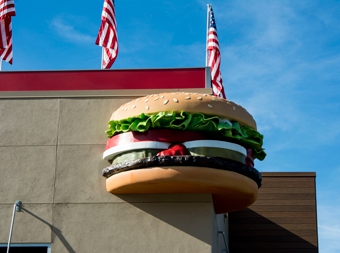The order for this larger-than-life burger came from one of the biggest franchisees of a popular burger chain, who was looking to do something different at a new location. The franchisee knew that it would take a special shop to cook up this custom burger, so he called US Signcrafters in Indiana.
“We have a long-term relationship of fifteen years with the client, and they just flat-out trusted [us] to get it done,” says Jeffrey Trenery, president of US Signcrafters.
Using a combination of both Adobe Illustrator and SAi Flexi software, Trenery got to work on designing a burger that looked like the chain’s popular menu item.
Aside from getting the look right and ensuring all the proper ingredients were displayed on the burger—lettuce, tomato, onion, pickles, mayonnaise, and ketchup—US Signcrafters had to figure out how the sign would be mounted to the corner of the building.
The final design called for a burger with a triangle wedge missing from the back, which would accommodate mounting plates and allow the piece to fit flush to the corner of the building.
It was decided the large burger would have to be sculpted from foam, so US Signcrafters called on Peachtree City Foamcraft to handle the fabrication. “I’ve known them for probably fifteen years as well,” says Trenery, “and I’ve used them for plenty of foam-based monument signs in the past.”
US Signcrafters provided Peachtree with the burger’s design as well as the aluminum mounting plates so they could be incorporated into the foam build.
It was now up to Peachtree to create an appetizing burger.
“When creating a three-dimensional piece from a concept drawing, we will take creative license to do whatever it takes to achieve a certain look or feel,” says Michael Fetter, sales manager of Peachtree. “Peachtree City Foamcraft has several artists and sculptors who form a team to manipulate several types of foam that could be cut, sculpted, bent, or shaped into the pieces required to make the unit.”
The burger was sculpted from expanded polystyrene foam.
“The shapes were individually cut by multi-axis contour-cutting machines utilizing vector art provided by the customer and manipulated to meet our needs,” explains Fetter. “Anything that could not be machined was hand sculpted to meet the design of the project.”
Of all the parts of the burger, the lettuce proved the most difficult to recreate, but Peachtree got it done.
“The fun part of creating 3D sign images is that we always run into situations that challenge our employees to rise to the occasion,” says Fetter. “The major challenge was creating lettuce that looked real, and through trial and error, we were able to create the product you see today.”
Since the burger would be mounted outside and exposed to the elements, proper precautions were taken to protect the 3D sculpture by applying acrylic paints along with a Poly-Armor™ Hard Coat finishing system.
“Our products are finished with 100 percent acrylics combined with the foam and Poly-Armor to create a 100 percent synthetic product that will allow for all three products to expand and contract at the same rate—eliminating the chance of cracking, peeling, and delaminating due to high/cold temperatures,” says Fetter.
In all, the design, engineering, and fabrication took about six weeks. When the burger was completed, Peachtree crated and wrapped it up for shipping to US Signcrafters.
Since the burger was being installed onto a franchise location in Gainesville, Florida, US Signcrafters didn’t perform the installation. Instead they thoroughly prepped and prepared the client for the installation beforehand.
“I worked with their vice president of construction down there, and I talked them through the installation process, which was a piece of cake,” says Trenery. “It’s actually on a parapet wall, so it’s thru-bolted through the back.”
US Signcrafters also provided a pattern for the drilling.
“We made the pattern for them out of aluminum,” says Trenery. “It was two-piece, so they bolted that together, which made the 90-degree angle and went right on the corner of the building.
“Paper could have been stretched, it could have went on crooked, so we just felt safer with aluminum.”
Using the pattern, the client marked the holes, drilled through the parapet, lifted and held the burger up with service equipment, and then mounted it to the wall using threaded rod double-nutted from the back.
The franchisee kept the burger covered until the grand opening, which was attended by members of corporate.
It’s safe to say that no one went hungry at this 3D burger unveiling!
By Ashley Bray
Photos (top to bottom): Mike Shea Photography, Mike Shea Photography, US Signcrafters.











